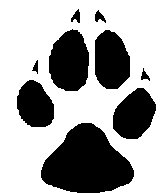|

~Paw Structure~
Humans are plantigrade, walking upon our entire flat foot, sole to heel. All members of the canine family, and the feline family too, are digitigrade, walking upon just their toe tips. Unless a wolf is lying down, the heel of each foot does not come in contact with the ground. The front feet of a wolf are exceptionally large. This is of great advantage to the wolf when it runs upon snow, as it allows greater weight distribution and more support to prevent the animal from sinking in as deeply when the snow is soft.
The wolf has five toes on each forefoot, but only four are actually needed. The fifth toe, corresponding to our thumb, has regressed. It is found up on the middle of the foot and is known as the dew claw. There are just four toes on each of the hind feet. Each toe pad is surrounded by stiff, bristly hairs, which act as insulation and also provides a better grip on slippery ice surfaces. The claws are strong and blunt because the tips are worn off by constant contact with the ground. These are used for digging and in gripping the earth while running, not for seizing prey.
~Speed~
Wolves walk, trot, lope, or gallop. Their legs are long, and they walk at about 4 miles per hour, but can reach speeds of 45 mph during a chase. Their usual mode of travel is to trot, which they do at various speeds, generally between 8 to 10 miles per hour.
Wolves do not run at full speed until they get close to their prey as possible. At that point, they make a high-speed chase to test the animal.
Wolves can keep up this pace for hours on end and have been known to cover 40 miles in a single night. They have been clocked at speeds of over 40 miles per hour for a distance of several miles. 
|

